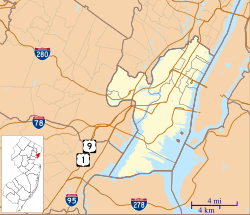William Hall Walker Gymnasium | |
 | |
| Location | Sixth Street at Fieldhouse Road, Castle Point on Hudson Hoboken, New Jersey |
|---|---|
| Coordinates | 40°44′37″N74°1′33″W / 40.74361°N 74.02583°W |
| Built | 1915–1916 |
| Architect | Ludlow and Peabody |
| Architectural style | Classical Revival |
| NRHP reference No. | 100003907 [1] [2] |
| NJRHP No. | 5700 [3] |
| Significant dates | |
| Added to NRHP | May 9, 2019 |
| Designated NJRHP | March 15, 2019 |
The William Hall Walker Gymnasium is an athletic facility on the campus of the Stevens Institute of Technology in the City of Hoboken in Hudson County, New Jersey. It is located near Sixth Street on Fieldhouse Road in the Castle Point section of the city. Built from 1915 to 1916, the building was added to the National Register of Historic Places on May 9, 2019, for its significance in architecture. [4]



